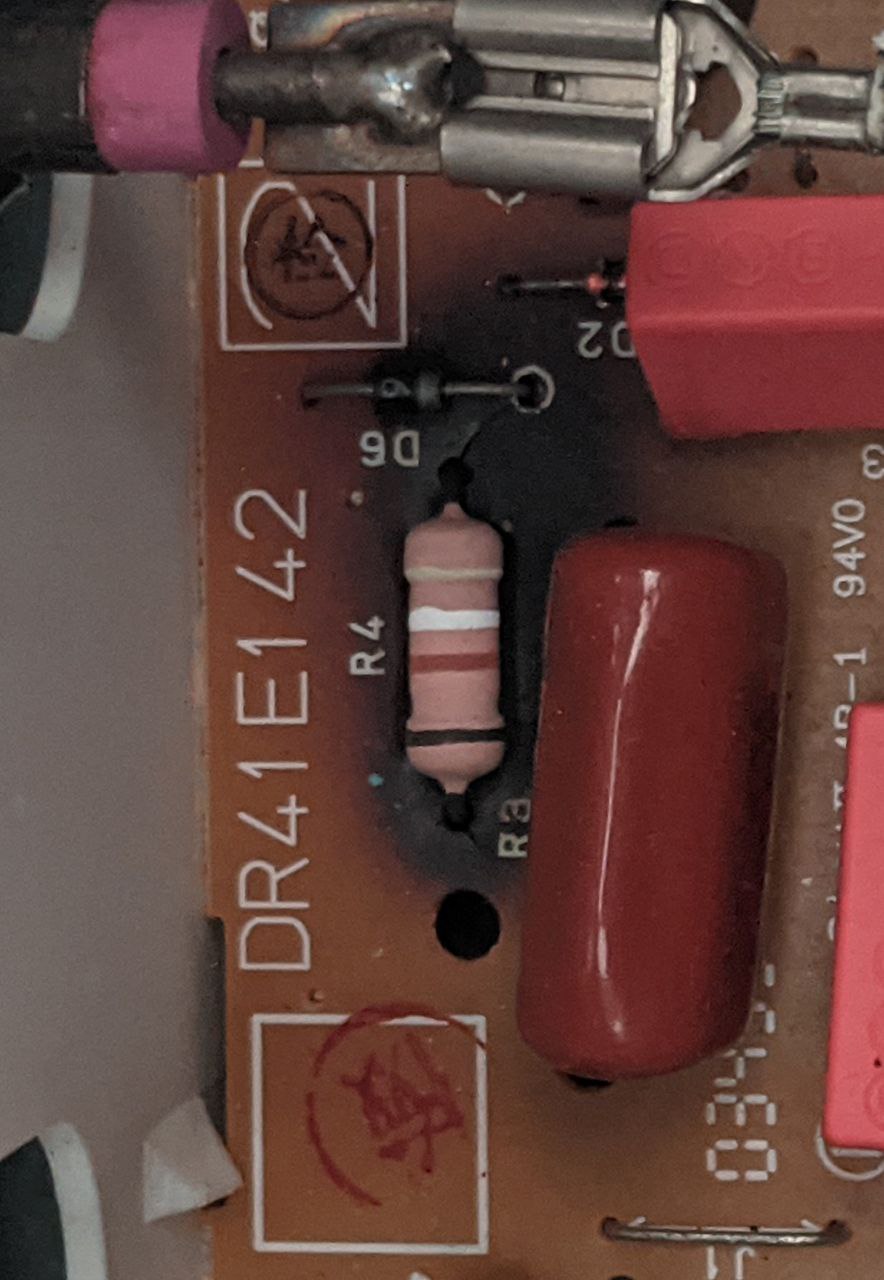this post was submitted on 04 Jul 2023
25 points (100.0% liked)
Ask Electronics
3559 readers
5 users here now
For questions about component-level electronic circuits, tools and equipment.
Rules
1: Be nice.
2: Be on-topic (eg: Electronic, not electrical).
3: No commercial stuff, buying, selling or valuations.
4: Be safe.
founded 2 years ago
MODERATORS
you are viewing a single comment's thread
view the rest of the comments
view the rest of the comments

It looks like 1GΩ (black-brown-white gold). But that doesn't sound likely unless you have a very high voltage bread maker.
If we treat the black band as discolored-brown, and read it the other way, we get (yellow - white - brown - brown) which is 490Ω and closer to your measured value. I wouldn't rule out (yellow - white red - brown) either at 4.9 kΩ, although that doesn't match closely to your measurement.
A good question is 'why did the resistor burn?'. If I didn't know why, then I would assume that replacing it will just result in it burning again, although maybe not immediately.
Success!
Thanks! I'll try replacing it with a 490 ohm resistor and see if it works again.
The element in the bread maker looks like it came loose a bit and made slight contact with the internal metal housing. I wonder if that caused the resistive element to sink more current than the PCB was designed for, burning out the resistor.
That sounds like a possible fail state. Also shitty design. It should use a resettable thermal fuse or something to detect faults without parts burning.
Consider maybe adding a fuse to the design?
You'll need a fairly high wattage resistor. That one looks like maybe 1W but it might be more.
Isn't it safer/better to start by replacing and testing with a higher resistor? Or is my thinking too simple?
Well, arguably keeping the resistor the same value would result in a somewhat known state, and changing it would put it in an unknown state. The unknown state could be better or worse. I can't see enough to know what the circuit does to say.
What you could do instead, is set the resistor to the same value, but rated for higher thermal dissipation. Then measure how hot it gets to identify if the real problem is somewhere else. Another part might burn/explode instead though, so I'd consider carefully how to proceed, and probably wear goggles + have a fire extinguisher in the room.
My main concern is by 'fixing' it with a resistor with higher thermal dissipation, I've created a fire hazard because that dissipated heat now has to 'go somewhere', which may be the plastic case. A thermal camera is handy to see if some part of the board gets unacceptably hot during normal operation.
The case is basically fully metal, just a bit of plastic inside for mounting the PCB to and a few other bits of plastic outside. Plus there is a temperature fuse in the case also.
From the resistor size (11.5 x 4.5mm) I think it would have been a 2W resistor when comparing to sizes on Digikey. I made a 500 Ohm 2W resistor from 8 1/4W 1K resistors then put a larger resistor in parallel to that to bring it down, measured it to 489 Ohms.
I'm going to run it a few times then open it up again to see if there is any new damage to the board before returning it.
Sounds like science! Let us know what happens.
Four loafs of bread later with no issues, opened it up and everything looks fine :)
Thank you for the detailed insight! I miss some basics in electronics but am eager to learn how to test and fix circuits.
Years ago I tried to repair an old keyboard/synthesizer by cleaning it and replacing leaked/bloated capacitors. Unfortunately the onboard sound memory could not be loaded anymore or was wiped entirely as far as I understood. But due to lack of knowledge (me and community that time) it was too complex to got the keyboard up and running again. It's sometimes sad to loose good hardware...
Back to the resistor/thread: I can't imagine a resistor to be the source of the problem. Isn't it more possible that a capacitor wears out or a transistor cooling fails?
Those things are indeed more common!
However, if the circuit was in an abnormal state (e.g. the contact with the case), then a resistor could very well blow. It would not be surprising if it took some other components down with it, and that this damage is not obvious yet. "The transistor blows to protect the fuse" is a common fail-state, facetiously stated.
Another possibility is just... bad design. You could call me adequate at circuit design (I mostly design prototypes, not finished systems that have to last thousands of hours), but regularly see commercial products designed poorly with some stupid point of failure. For example, using a 1 watt resistor that is dissipating close to 1 watt, instead of designing a more efficient system that doesn't require dissipating heat at all.
I spend a lot of time answering questions for people just getting started. Probably 75% of them boil down to a few things. Here is that list in case amusing / useful:
Most of the rest is refusing to do other people's homework, help people build weapons, or do unwise things with mains power / high voltage / centrifuges. Occasionally people ask me really interesting questions though, so I don't mind that the interactions are a bit scripted the rest of the time! I've noticed on Lemmy I've gotten much more interesting questions so far!